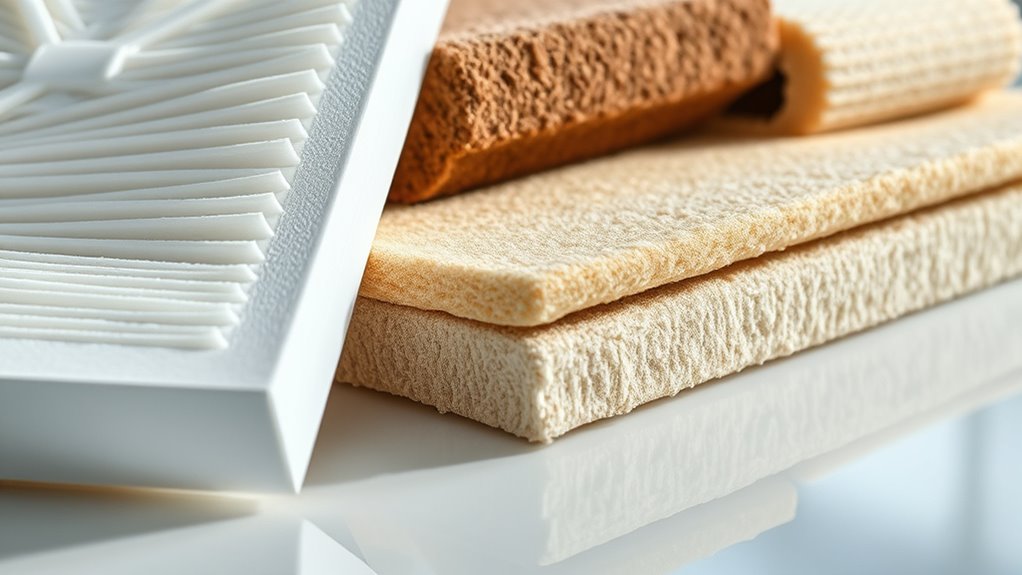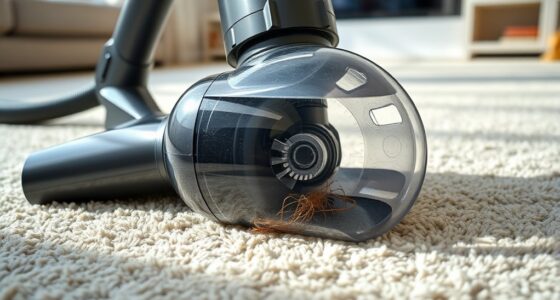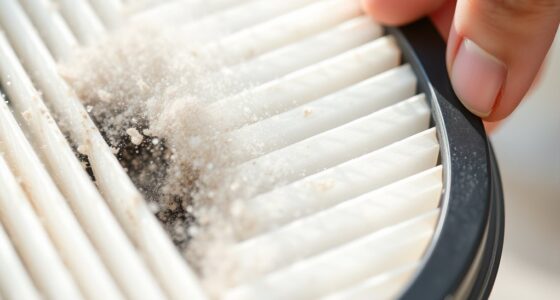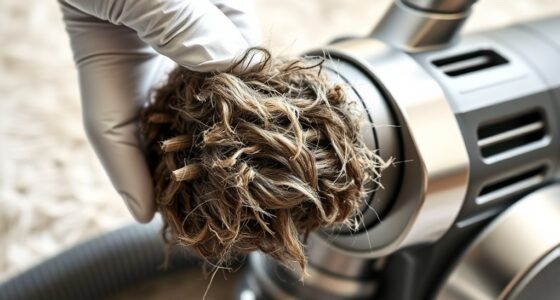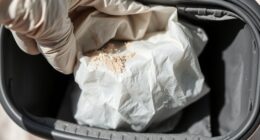To clean your vacuum filters—HEPA, foam, or cloth—check the manufacturer’s instructions first. HEPA filters often need gentle tapping or air blowouts, and some can be washed in cold water, then air dried completely. Foam filters should be rinsed under cold water, then thoroughly dried before reinstalling. Cloth filters are best washed with mild detergent and dried flat. Keeping up with these methods guarantees your vacuum stays efficient; more tips await below.
Key Takeaways
- Check manufacturer instructions before washing HEPA, foam, or cloth filters to ensure proper cleaning methods.
- HEPA filters can be cleaned by gentle tapping, compressed air, or washing if specified; air dry thoroughly before reuse.
- Rinse foam filters under cold water until clear, then squeeze out excess water and air dry completely before reinstalling.
- Wash cloth filters in warm water with mild detergent, rinse thoroughly, squeeze out excess water, and dry flat to prevent mold.
- Regularly clean filters every few months to maintain vacuum suction, prevent dirt buildup, and ensure optimal air quality.

Have you ever wondered why your vacuum isn’t performing as well as it used to? The issue often comes down to filter maintenance. Over time, filters can become clogged with dirt, dust, and allergens, which reduces airflow and suction power. Regularly cleaning your vacuum filters is essential to keep your machine running efficiently. Establishing cleaning schedules helps prevent buildup and ensures your vacuum maintains peak performance. Depending on the type of filter your vacuum uses—HEPA, foam, or cloth—the cleaning process varies slightly, but consistency is key regardless of the filter type.
Regular filter maintenance keeps your vacuum running efficiently and prolongs its lifespan.
For HEPA filters, which are designed to trap tiny particles and improve air quality, it’s tempting to think they’re maintenance-free. However, HEPA filters require periodic cleaning to keep them functioning properly. Many HEPA filters can be gently tapped to remove loose dust or blown out with compressed air, but some are washable. Always check your vacuum’s user manual before washing, as improper cleaning can damage the filter. When washing a HEPA filter, use cold water and avoid soap or detergents, then let it air dry completely before reinstalling. This prevents mold growth and maintains filtration efficiency. Keep in mind that HEPA filters typically have a lifespan of six to twelve months, so replacing them regularly is often necessary if they are not washable.
Foam filters are usually found in upright and handheld vacuums. Cleaning these is straightforward: remove the foam filter and rinse it under cold water until the water runs clear. Gently squeeze out excess water—never wring or twist—and let it air dry completely before reinserting. Foam filters dry quickly, often within a few hours, but ensure they’re fully dry to prevent mold or unpleasant odors. Incorporate filter checks into your cleaning schedules, ideally every few months, or more frequently if you have pets or allergies that cause more debris to accumulate.
Cloth filters are often washable and reusable. Remove the cloth filter and shake off loose dust, then wash it in warm water with a mild detergent. Rinse thoroughly and squeeze out excess water, then lay it flat to dry. Make sure the filter is completely dry before reinstalling it to avoid mold growth. Setting a regular cleaning schedule for cloth filters—say, every three to four months—helps keep your vacuum performing at its best. Neglecting these schedules means dirt and allergens can clog the filter, reducing suction and letting dust escape into the air.
Maintaining your vacuum filters isn’t complicated, but it’s crucial. By sticking to consistent cleaning schedules and understanding the specific needs of each filter type, you’ll prolong your vacuum’s lifespan and ensure cleaner, healthier air in your home.
Frequently Asked Questions
How Often Should I Replace My Vacuum Filters?
You should replace your vacuum filters based on their filter lifespan and your replacement schedule. Generally, HEPA filters need replacing every 6 to 12 months, while foam and cloth filters may last longer but should be checked monthly. If you notice reduced suction, increased dust, or musty odors, it’s time to replace or wash them. Regularly following your vacuum’s guidelines guarantees peak performance and cleaner air.
Can I Clean Filters With Harsh Chemicals?
Sure, go ahead and use harsh chemicals on your filters—what’s the worst that could happen? In reality, chemical cleaning can damage filter durability and ruin the delicate fibers, especially for HEPA, foam, or cloth filters. For best results, stick to gentle soap and water. Your vacuum will thank you with better performance, and you’ll avoid costly replacements caused by chemical-induced damage.
Are There Special Considerations for Allergy Sufferers?
If you’re an allergy sufferer, you should handle vacuum filters carefully to maintain air quality and minimize allergy triggers. Use gentle cleaning methods, like rinsing HEPA filters with water if allowed, and avoid harsh chemicals that could release irritants. Regularly replace or clean filters to guarantee ideal performance. Keeping filters clean helps reduce airborne allergens, making your home healthier and more comfortable.
What Are the Signs of a Clogged or Damaged Filter?
You’ll notice your vacuum isn’t performing as well—irony? That’s a clue your filter’s clogging or damaged. Warning indicators may light up, or suction drops unexpectedly. If your filter’s lifespan has expired, or if debris escapes into the airflow, it’s time to check for signs of clogging or damage. Ignoring these signs can reduce efficiency and harm your vacuum’s motor, so be proactive!
Do Different Vacuum Brands Require Unique Cleaning Methods?
Different vacuum brands often require specific cleaning methods due to vacuum filter compatibility and brand-specific cleaning instructions. You should always check your vacuum’s manual for the recommended cleaning process, as some filters need gentle hand washing, while others may be rinsed or replaced entirely. Ignoring brand-specific cleaning procedures can damage filters or reduce their effectiveness, so follow the manufacturer’s guidelines to guarantee ideal performance and longevity of your vacuum.
Conclusion
Think of your vacuum filters as the lungs of your cleaning machine. When you keep them clean, they breathe freely, capturing every speck of dust and allergens. Regular washing of HEPA, foam, and cloth filters is like giving your vacuum a fresh set of lungs, ensuring it performs at its best. So, make filter maintenance a routine habit—your home will breathe easier, and your vacuum will thank you for it.
